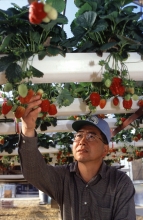USDA. AMS. NOP. Hydroponic and Aquaponic Task Force.
This 2016 report, submitted to National Organic Standards Board (NOSB), "1) describes the current state of technologies and practices used in hydroponics and aquaponics; and 2) ... examines how those practices align or do not align with the Organic Foods Production Act (OFPA) and the USDA organic regulations."

 Hydroponics, or growing plants in a nutrient solution root medium, is a growing area of commercial food production and also is used for home food production by hobbyists. Learn about the state-of-the-art techniques for producing food in a controlled, soilless setting.
Hydroponics, or growing plants in a nutrient solution root medium, is a growing area of commercial food production and also is used for home food production by hobbyists. Learn about the state-of-the-art techniques for producing food in a controlled, soilless setting.